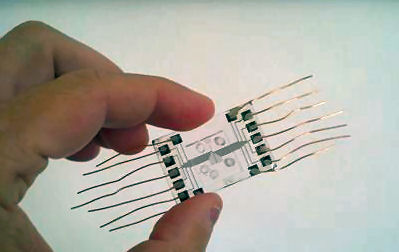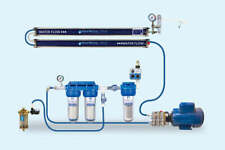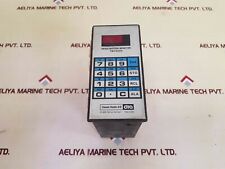
Using a small electrical field that removes the salts from seawater, German and American scientists have invented a new method for the desalination of seawater that consumes much less energy and is dramatically simpler than conventional desalination techniques. The new technique, known as electrochemically mediated seawater desalination, is described in the journal Angewandte Chemie.
To achieve desalination, the researchers apply a small voltage (3.0 volts) to a plastic chip filled with seawater. The chip contains a microchannel with two branches. At the junction of the channel an embedded electrode neutralizes some of the chloride ions in seawater to create an “ion depletion zone” that increases the local electric field compared with the rest of the channel. This change in the electric field is sufficient to redirect salts into one branch, allowing desalinated water to pass through the other branch.

“This was a proof of principle,” explained researcher Kyle Knust, from The University of Texas at Austin. “We’ve made comparable performance improvements while developing other applications based on the formation of an ion depletion zone. That suggests that 99 percent desalination is not beyond our reach.”
The other major challenge is to scale up the process. At present, the microchannels, about the size of a human hair, produce about 40 nanoliters of desalted water per minute. To make this technique practical for individual or communal use, a device would have to produce liters of water per day. The researchers are confident that this can be achieved as well.
If these engineering challenges are surmounted, the researchers foresee a future in which the technology is deployed at different scales to meet different needs – from small disaster relief arrays to municipal-scale units. They predict a small system about the size of a Coke machine could produce enough water for a small village.
The new method, which is patent-pending and in commercial development by startup company Okeanos Technologies, holds particular promise for the water-stressed areas in which about a third of the planet’s inhabitants live. Many of these regions have access to abundant seawater but not to the energy infrastructure or money necessary to desalt water using conventional technology.
“Current methods for desalinating water rely on expensive and easily contaminated membranes. The membrane-free method we’ve developed still needs to be refined and scaled up, but one day it might be possible to provide fresh water on a massive scale using a simple, even portable, system,” concluded lead researcher Richard Crooks, also from The University of Texas at Austin.
Related:
Discuss this article in our forum
Massive depletion of Middle East freshwater reserves
Salinity differential turns river mouths into power plants
Study finds alarming changes in rainfall patterns
Grim Future For Global Water Resources


















Comments are closed.